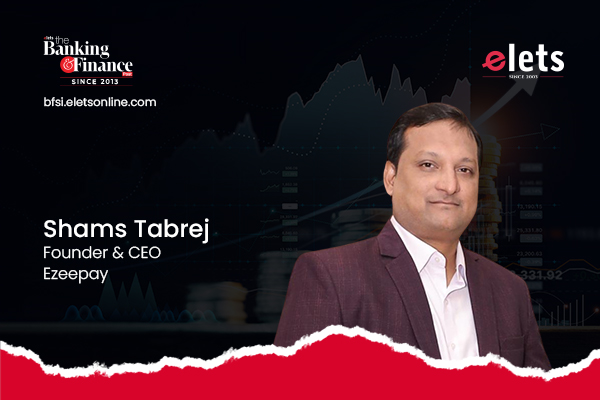India’s financial transformation is no longer confined to urban centres. From biometric-enabled banking in villages to AI-powered support in vernacular languages, the grassroots fintech movement is reshaping access and agency across Bharat. As digital public infrastructure matures and fintechs innovate at the edge, the focus is shifting from inclusion to true empowerment, where trust, technology, and local relevance intersect. Shared Shams Tabrej, Founder & CEO at Ezeepay, in an exclusive interaction with Vishwas Sinha of Elets News Network (ENN). Edited excerpts:
India’s fintech ecosystem has rapidly evolved over the past decade, especially in Tier 2 and Tier 3 cities. What do you see as the biggest enablers of this shift, and where do the next major opportunities lie?
In the past ten years, the growth of fintech in Tier 2 and Tier 3 cities has seen transformative changes. Mass acceptance of smartphones, along with cheap internet, made a digital-first population out of the semi-urban and rural segments. Initiatives like Jan Dhan Yojana, Aadhaar, and UPI have put other possible digital inclusions on a solid foundation towards onboarding their unbanked population. And then comes the rise of local entrepreneurs and agents who fill the last-mile gap, providing assisted digital services to users who are less familiar with the technology. This human-digital hybrid has worked well in establishing trust and accelerating adoption.
The next promising area of opportunity will be to deepen financial literacy, as well as the invention of financial products that are tailor-made for the region. Microcredit, digital insurance, and embedded finance, depending on local needs, shall play an important role. The use of AI for vernacular support and fraud detection will add to accessibility and security, driving a responsible scale.
The BFSI sector is witnessing a wave of AI integration—from fraud detection to customer service automation. How is EZEEPAY leveraging AI and automation to enhance user experience and operational efficiency?
The BFSI industries are undergoing a fundamental change with AI, and at Ezeepay, we look at it as an engine to scale efficiently while being responsive to customer needs. Integrating AI and automation to streamline backend operations and offer enhanced UI across the board has had our attention.
In fraud detection, AI models review transaction patterns and preemptively identify anomalies and interventions in real time. This, in turn, protects users and generates trust in financial services. Additionally, customer support is automated through AI-powered chatbot systems handling queries across many languages within seconds, reducing wait times and enabling real-time support for users in remote areas. User behavior analytics via AI also helps to tailor products and services. Whether by suggesting suitable services to users or improving agent workflows, automation aids us in remaining agile and user-first. We aim to ensure ease of access to basic financial services while keeping the ecosystem secure and inclusive.
Micro-ATMs and AEPS have become powerful tools for last-mile banking. How do you assess their long-term sustainability, and what innovations do you foresee enhancing their utility further?
Micro-ATMs, AEPS, and some other types of financial instruments have emerged as strong pillars of last-mile banking, making secure, biometric-based transactions possible in areas where traditional banking infrastructure is lacking. These instruments can be sustainable only if they move towards mutual interoperability, a higher uptime, and increased value-added services.
What makes these instruments resilient is cheap rendering, no heavy infrastructure requirements, and the ability to work on available rural networks. But to sustain their viability, they need evolution. Future innovations may well revolve around bundling diverse services like insurance, microcredit, and utility payments into one platform and transforming micro-ATMs into full-fledged financial access points. Using AI to improve biometrics and having vernacular voice interfaces will enhance accessibility for the less literate. Apart from that, offline transaction capabilities and higher agent training would become critical from an execution perspective so that services are delivered with grace despite connectivity challenges. Looking from a wider perspective, micro-ATMs and AEPS would remain an essential mechanism for financial inclusion.
Many fintechs are moving toward embedded finance and “super app” models. Do you see EZEEPAY heading in that direction, and how might that evolve in the next few years?
The trend towards super apps and embedded finance models is a larger one of embedding financial services in common digital use. For platforms with diverse and frequently underserved user bases, this intersection is not only tactical but also imperative. From Ezeepay’s perspective, we believe there’s a high opportunity here, as users increasingly demand frictionless access to a suite of services within a single interface.
Evolution won’t be about piling on features but about crafting an ecosystem where services ranging from payments and lending to insurance and bill payments are contextually applicable and convenient. Not only does it enhance user engagement, but it also minimises friction, particularly in semi-urban and rural markets where digital familiarity might yet be in the process of development. In the coming years, we expect more integration of services among various sectors facilitated through APIs and collaborations. Personalisation driven by AI would also be a key factor in providing timely, need-driven financial products within such platforms. The aim would be to create digital ecosystems fulfilling users’ real-world requirements while driving financial inclusion meaningfully and at scale.
With a current reach of 7 lakh retailers, how critical is retailer empowerment—training, incentives, tech support—to the success of a B2B2C model like EZEEPAY’s?
With more than 7 lakh retailers serving as the first point of contact between technology and end users in a B2B2C model like ours, empowering the partners is not just necessary, but it’s needed. Retailers are the last-mile delivery bridge, particularly in those areas where trust in digital systems is still forming. Whether they can elucidate, implement, and maintain services is what decides the customer experience quality.
Training is provided to support them not just in using the platform but also in educating customers, solving problems, and maintaining compliance standards. Incentive models also propel performance and retention, making the retailers feel appreciated and encouraged to build their business. With digital services growing each day, our retailer ecosystem needs to grow in capability. Essentially, the success of the B2B2C model hinges on how well we empower retailers to be digital enablers in their local communities. Empowering them has direct implications for the adoption, scale, and sustainability of financial inclusion initiatives over the long term.
What role do public policy initiatives—like PMJDY, UPI 123Pay, or RBI’s digital rupee pilot—play in shaping fintech strategies for companies like yours?
Public policy programs have had a revolutionary impact on defining fintech strategies, especially for organisations with the goal of financial inclusion. Initiatives such as PMJDY set the stage by integrating millions into the formal financial system so that the fintech platforms could construct services for an unreachable base.
UPI 123Pay is another important milestone in closing the digital divide by offering UPI services to feature phone users without connectivity. This creates new opportunities for innovation in semi-urban and rural markets, where smartphones and digital awareness are not yet widespread. It forces fintechs to think differently, creating solutions that are easy and secure. The RBI’s digital rupee pilot adds yet another layer, signaling the future of programmable and traceable currency. While still evolving, it nudges fintechs to anticipate integration pathways and explore use cases such as offline payments and government benefits disbursement.
The BFSI sector has become a hotspot for cyber threats and fraud. How do you think the industry should balance speed, accessibility, and data security, especially in rural-focused financial platforms?
Balancing speed, convenience, and data protection is perhaps the biggest challenge facing the BFSI industry today, particularly for websites catering to rural and semi-urban areas. These tend to be dependent on assisted digital models, which can pose higher risks if managed inadequately. Additionally, to meet this, the sector needs to implement a layered security strategy. This involves real-time AI-fueled fraud detection systems, strong authentication methods such as biometrics, and secure APIs. At the same time, education also plays an important part. Agents and customers both should be periodically trained in best practices in cybersecurity in order to mitigate phishing, identity theft, or unauthorised transaction risks.
In the end, speed and access should not be sacrificed for trust. Secure yet intuitive systems combined with open communication and ongoing vigilance can foster a more secure environment without hindering innovation. It is not only the responsibility of fintech companies, however, but also the entire ecosystem of regulators, technology vendors, and community stakeholders to make inclusive and secure growth.
With 7 lakh retail outlets and a 2025 target of 1 million users, how does EZEEPAY ensure retailer engagement and service quality at such a wide scale?
With a rapidly expanding network of over 7 lakh retail touchpoints, ensuring consistent retailer engagement and exceptional service delivery remains both a complex logistical undertaking and a key strategic priority. Consistency is the key to success at such a scale. We tackle this with a mix of technology, training, and community building. First, our technology infrastructure is designed to track service performance in real-time, identifying problems and maintaining uptime by location. But technology isn’t the complete solution. Ongoing training—both online and on-site empowers retailers to process transactions with confidence, resolve everyday problems, and train customers. Incentives, too, have a powerful role to play. Pay-for-performance rewards and recognition not only motivate but also instill a feeling of ownership in retailers, too. Besides, we have focused support channels so that timely support can be offered, minimising downtime and maintaining service continuity.
Just as significant is hearing our retailers out. Feedback loops enable us to tailor tools and workflows to their actual on-ground needs. By doing so, we do not simply ensure quality—we forge long-term relationships. In an era when digital trust is yet to be built in much of India, empowered and motivated retailers are our best ambassadors on the ground.
With the increasing overlap between fintech, insuretech, and regtech, is India moving toward a consolidated “digital finance stack”? What implications could this convergence have on traditional financial institutions and rural economies?
India is converging toward an increasingly integrated “digital finance stack” where fintech, insuretech, and regtech are becoming increasingly intermeshed. The common motive behind this convergence is to provide efficient, secure, and inclusive financial services at scale. APIs, Aadhaar-based authentication, UPI, and account aggregators are facilitating this transition by developing a shared infrastructure that enables real-time, interoperable services.
For conventional financial institutions, this is both a threat and an opportunity. They will need to respond to more accelerated innovation cycles and increased consumer expectations, frequently through collaboration with or acquisition of fintech competencies. Institutions that adapt to this change can expand reach and improve efficiency, particularly to underserved populations.
For rural economies, the stakes are high. A single digital stack can make credit, insurance, and compliance easier to access—frequently hurdles for small businesses and individuals there. With the proper guardrails, it can cut friction, decrease costs, and encourage participation in the formal economy.
Also Read: RegTech Innovations: Automating KYC/AML for Global Operations
Looking five years ahead, what is your vision for how fintech companies can move beyond financial inclusion to becoming full-scale digital enablers of economic mobility across India?
Five years into the future, the vision for fintech in India needs to go beyond access to banking to actually empower economic mobility. Financial inclusion is the starting point, but empowerment comes next: assisting people and small businesses to establish credit profiles, gain access to growth capital, and engage in the formal economy without fear.
Fintech firms are ideally situated to be digital enablers by capturing data, collaborating with other firms, and utilising technology to build value-generating ecosystems. That may involve providing microloans based on transaction history, combining insurance with everyday services, or giving digital platforms to small retailers to track inventory and sell.
In rural and disadvantaged areas, the focus should be on establishing trust, enhancing financial literacy, and creating products locally printed in local languages, suited to local demands. Notably, this transformation must be inclusive, crossing gender divides, helping migrant workers, and making products available to low-literacy groups.
Fintech’s function will increasingly be not only about providing financial products, but about unlocking upward mobility. When harnessed responsibly into areas such as agriculture, education, and health, fintech has the potential to be a driver of a more equitable and independent economy. The true barometer of success will be how significantly we lift communities, rather than onboard users.
Elets The Banking and Finance Post Magazine has carved out a niche for itself in the crowded market with exclusive & unique content. Get in-depth insights on trend-setting innovations & transformation in the BFSI sector. Best offers for Print + Digital issues! Subscribe here➔ www.eletsonline.com/subscription/
















